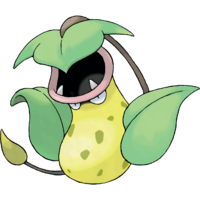On the Origin of Species: Victreebel
|
When I was young I had a fascination with carnivorous plants. They seemed to be such a pleasing reversal of the natural order. Typically, plants were at the mercy of insects. An insect could show up and start eating a plant, and the plant just had to sit there and take it. Carnivorous plants represented a sort of poetic justice to my young mind; the hunter becoming the hunted. Of course, that's not how it works in reality, but the idea of a plant as something actively dangerous to its would-be predators was an engaging one.
Carnivorous plants aren't carnivorous in the sense that animals are: they don't get any energy from the prey they devour, as they have photosynthesis for that. What the plants really want are additional nutrients that are scarce in their native environments. Most commonly this means various forms of nitrogen, which is essential for making protein. Thus, carnivorous plants are most often found in low-nitrogen or acidic environments, and their creative solution to the problem is to entice nitrogen-rich animals, and then take it from them.
The most iconic carnivorous plant by far is the Venus flytrap (Dionaea muscipula). There's something inherently fascinating about a plant that's able to move rapidly by itself. The Pokémon series did eventually give us a Venus flytrap Pokémon with Generation IV's Carnivine, but as the series often does, it began with something a little more obscure. Victreebel and its relatives are based on pitcher plants, a group of plants that catch their prey with an arrangement known as a pitfall trap.
Pitcher plants can be split into two groups: those of the Nepenthes genus, which are found in Southeast Asia, Madagascar and Northern Australia, and the Sarraceniaceae family, found across the Americas. It's thought that at least some of them evolved from more simple predatory plants called flypaper traps, which ensnare their prey with a glue-like substance on the surface of their leaves. Over time, the leaves folded inward, resulting in the cup-like structure we see today. Victreebel seems to have much more in common with the Nepenthes genus, so that's the group we'll be concentrating on today.
The rim around a Nepenthes trap is often very brightly colored to attract insects. It's also slippery, and insects landing upon it are likely to end up falling inside. The interior of the trap has a smooth, waxy surface that's difficult or impossible to climb up. And then there's the fluid.
Yes, the plants contain a special fluid that traps, drowns and digests prey. While it looks much like water, it contains unique and sticky biopolymers that further prevent escape. The extracted nutrients can then be absorbed by glands at the bottom of the cup. Prey is usually limited to invertebrates: insects, spiders and the occasional slug. But some larger pitchers sometimes snag bigger prey: Nepenthes rajah and Nepenthes rafflesiana have been known to trap lizards, frogs, rodents and on some occasions even birds. No wonder the anime's James was so distressed by the embrace of his over-affectionate Victreebel.
The large leaf that sits above many varieties of Nepenthes traps also has an important function to play, acting as a lid. This isn't, as you might imagine, to keep prey from getting out, but to keep rain from getting in. Rainwater would dilute the digestive fluid and make it less effective, and a lot of rainwater would cause the trap to overflow, so it's important to limit the amount of water that can get in.
With such a reputation for deadliness, it might be sensible to assume that animals would do their best to avoid pitcher plants whenever possible. But this isn't always the case, and many Nepenthes species have developed strange alliances with other creatures. Nepenthes lowii actually seems to get most of its nutrition from tree shrew droppings: it does this by producing a sugary substance on its lid that the shrews can feed on while perching over its opening, earning it the nickname "tree shrew lavatory". Nepenthes bicalcarata can act as a safe habitat for ants, which feed on some of the larger things the plant catches. This is beneficial to the plant too, since too much leftover prey in its trap would eventually rot and attract disease.
Despite the fact that pitcher plants are designed specifically for gobbling up insects, plenty of bugs seem to have found ways to colonize the plants. In fact, some insect species are completely dependent on the pitcher plants for their survival. The details of these relationships aren't fully understood, but it seems likely that the insects get shelter and food, while also aiding digestion and avoiding bacterial contamination by breaking down the larger catches. It's a surprisingly amicable arrangement for all.
So ultimately, the relationship between Nepenthes and its potential prey is a complicated one, and highly situational. It will happily consume anything that has the misfortune to fall into its trap, but it can also be a reliable ally and protector. Provided, of course, you can keep your footing.

